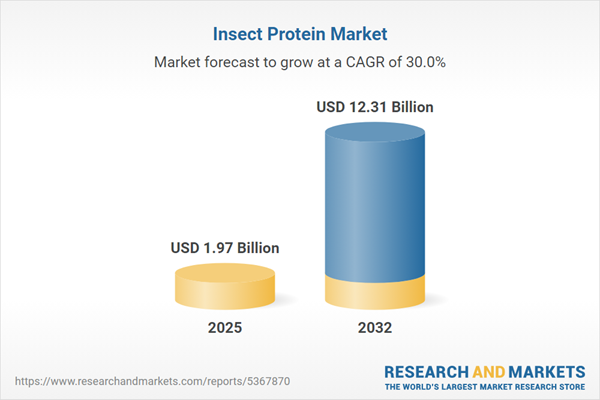Speak directly to the analyst to clarify any post sales queries you may have.
Senior executives in procurement and supply chain management are rapidly turning to alternative protein sources, such as insect protein, to navigate emerging challenges in global sourcing, regulatory compliance, and sustainability. As shifting market forces continue to reshape the food and feed landscape, understanding the insect protein market is essential for leaders aiming to maintain resilient operations and drive measurable business outcomes.
Market Snapshot: Insect Protein Market Growth and Opportunity
The insect protein market reached USD 1.50 billion in 2024 and is projected to attain USD 1.97 billion by 2025, with a compound annual growth rate of 30%. Significant growth is occurring across food production, animal feed, and aquaculture as organizations increasingly favor stable alternative proteins to protect their supply chains. This rapid expansion is supported by modernization in procurement processes, advanced logistics, and evolving regulatory environments that now encourage adoption. As insect protein becomes further embedded in supply chain planning, it empowers organizations to address sector-specific volatility and achieve broader environmental, social, and governance goals.
Scope & Segmentation: Strategic Insights for Senior Decision-Makers
- Application Segments: Animal feed—including poultry, aquaculture, swine, ruminant, and pet nutrition—as well as human food applications in baked goods, nutraceuticals, and dietary supplements. These segments address diverse sourcing requirements and support the trend toward nutrition alternatives in response to sustainability demands.
- Distribution Channels: Animal supply retailers, wholesale distribution, direct sales, online channels, e-commerce, and specialty markets. These channels enable enhanced transparency and facilitate agile, scalable procurement strategies for enterprises across multiple verticals.
- Insect Types: Black soldier fly, mealworm, and cricket are the leading species, each providing distinctive nutritional properties, flexibility in processing, and adaptability for integration into international food and feed supply chains.
- Product Forms: Crude oil, refined oil, powdered and paste concentrates, pellets, ready-to-use options, and whole insects. Such versatility supports sector-specific ingredient integration, streamlining operational and processing workflows.
- Regional Coverage: Major procurement activity spans North America, Latin America, Europe, Middle East, Africa, and Asia-Pacific—geographies shaped by unique regulatory frameworks and commercial priorities, each propelling distinctive procurement strategies.
- Leading Companies Analyzed: Protix B.V., Ynsect SAS, InnovaFeed SAS, AgriProtein Holdings, Aspire Food Group, EnviroFlight LLC, Beta Hatch Inc., Entomo Farms Inc., Hexafly Ltd, and NextProtein SAS. Analysis centers on innovation, technology adoption, and how the competitive landscape influences procurement choices and supply diversity.
Key Takeaways: Strategic Insights for Insect Protein Adoption
- Adoption of automation across production is improving scalability and ensuring consistent output quality for manufacturers in food and feed industries.
- Expansion of circular resource systems, such as the upcycling of organic by-products for insect feed, enhances sustainability and efficiency in resource utilization.
- Collaboration among agriculture technology providers, ingredient suppliers, and feed producers equips procurement teams with tailored, regionally relevant solutions, increasing the fit and flexibility of operations.
- Regulatory updates in various markets are supporting easier market access, lowering the complexity of compliance, and strengthening risk management during regulatory or supply disruptions.
- Adaptable business models are proving vital, as they allow procurement strategies to flex according to changing local and regional market conditions to maintain supply continuity.
- Ongoing consolidation across the industry is leading to broader supplier relationships, greater procurement options, and more diversified sourcing strategies to ensure long-term supply security.
Tariff Impact: Navigating New Cost Realities in the U.S. Market
Recent changes to United States tariffs on insect protein imports require refined sourcing strategies and careful supplier evaluation. Both U.S.-based and international producers are adjusting their operations to comply with new regulatory demands, prompting procurement leaders to place greater emphasis on cost oversight, risk mitigation, and operational stability to navigate evolving policy environments.
Research Methodology & Data Sources
This analysis is informed by interviews with senior executives, comprehensive facility assessments, and detailed reviews of current regulatory changes. The research approach ensures decision-makers gain actionable insight and practical guidance for procurement and market expansion within the insect protein sector.
Why This Report Matters to Senior Stakeholders
- Offers targeted guidance for procurement optimization, technology evaluation, and proactive risk management in the insect protein supply chain.
- Provides clarity on evolving regulatory and tariff environments to support robust, informed sourcing partnerships.
- Equips strategic planners with up-to-date market intelligence, supporting compliance initiatives and sustainability commitments.
Conclusion
Access to thorough insect protein market analysis positions senior leaders to proactively manage risk, advance sustainability goals, and support resilient procurement decisions in the face of ongoing market transformation.
Additional Product Information:
- Purchase of this report includes 1 year online access with quarterly updates.
- This report can be updated on request. Please contact our Customer Experience team using the Ask a Question widget on our website.
Table of Contents
3. Executive Summary
4. Market Overview
7. Cumulative Impact of Artificial Intelligence 2025
Companies Mentioned
The companies profiled in this Insect Protein market report include:- Protix B.V.
- Ynsect SAS
- InnovaFeed SAS
- AgriProtein Holdings Proprietary Limited
- Aspire Food Group, Inc.
- EnviroFlight, LLC
- Beta Hatch, Inc.
- Entomo Farms Incorporated
- Hexafly Limited
- NextProtein SAS
Table Information
| Report Attribute | Details |
|---|---|
| No. of Pages | 193 |
| Published | October 2025 |
| Forecast Period | 2025 - 2032 |
| Estimated Market Value ( USD | $ 1.97 Billion |
| Forecasted Market Value ( USD | $ 12.31 Billion |
| Compound Annual Growth Rate | 30.0% |
| Regions Covered | Global |
| No. of Companies Mentioned | 11 |









